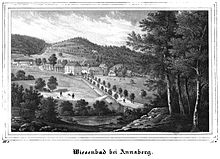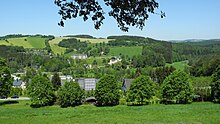Meadow pool
|
Meadow pool
Municipality of thermal bath Wiesenbad
Coordinates: 50 ° 37 ′ 11 " N , 13 ° 2 ′ 42" E
|
||
|---|---|---|
| Height : | 445 m | |
| Residents : | 664 (May 9, 2011) | |
| Incorporation : | January 1, 1999 | |
| Incorporated into: | Wiesa, now the Wiesenbad thermal baths | |
| Postal code : | 09488 | |
| Area code : | 03733 | |
|
Location of Wiesenbad in Saxony |
||
Wiesenbad is part of the Saxon community of Thermalbad Wiesenbad in the Ore Mountains District .
geography
Wiesenbad is located about 5 kilometers northeast of Annaberg-Buchholz in the Ore Mountains . The settlement lies on both sides of the Zschopau, which runs in a west-east direction . The federal road 101 Freiberg –Annaberg-Buchholz runs through the locality .
Neighboring places of Wiesenbad are Falkenbach in the north, Himmelmühle and Streckewalde in the northeast, Mauersberg , Mildenau and Plattenthal in the southeast, Geyersdorf in the south, Annaberg and Wiesa in the southwest, Schönfeld in the west and Neundorf in the northwest.
history
The first building on site was built in 1474 with the lordly mill of the knight in Wiesa. The original hamlet of Wiesenbad was built around a warm spring discovered at the turn of the 16th century on the right bank of the Zschopau. Until 1856 he belonged to the office of Wolkenstein .
In 1859 Jacob Bernhard Eisenstuck had a flax spinning mill ("Aktienspinnerei Wiesenbad") built in the village, which in 1877 was transferred to the Meyer & Co. AG company.
With the opening of the "Wiesenbad" station on February 1, 1866, the town received a railway connection on the Annaberg-Buchholz and Bf-Flöha line .
In 1914/15 the then co-owner of the flax spinning mill, Georg Polemann, had the so-called "Friedenskapelle" built on his own property and at his own expense. It was consecrated to church on July 13, 1919. The building does not belong to the parish, but to the founder's heirs to this day. The building has a no longer playable organ in the attic and the positive organ used today . In 1942 the three-part bell was removed for war purposes, and in 2005 a new two-part bell was purchased. In 1994 the roof was re-covered and in 2000 the building received a winged altar. In the course of renovation work in 2005/06, the original art nouveau painting was rediscovered and largely restored.
On January 1, 1956, the Wiesenbad thermal baths - not to be confused with today's community - were born out of the Wiesenbad village, which was spun off from Wiesa, the Himmelmühle and Hinterfalkenbach settlements spun off by Falkenbach, and the Plattenthal settlement . In 1964 the municipality of Thermalbad Wiesenbad had 1,445 inhabitants and in 1990 1,020 inhabitants.
In 1997, Wiesenbad received state recognition as a resort, and on April 21, 1999 it was designated as a "place with mineral springs". On January 1, 1999, the previously independent communities of Neundorf, Schönfeld, Wiesa and Wiesenbad thermal baths merged to form the new community of Wiesa.
In 1999/2000, demolition and development work began in the center of the village on the site of the former flax spinning mill for the purpose of building a new spa park and developing a new town center.
On January 1, 2005, the community was renamed Thermalbad Wiesenbad.
History of the thermal bath


The chronicler Christian Lehmann reports in his historical location about the warm spring on the right bank of the Zschopau, which was discovered at the turn of the 16th century, as well as the bath that was built a little later :
“It is said to have been invented by a poor man / […]. And because, especially after St. Annaberg's construction, other people who were in need of the press came together / Anno 1501. Hanß Friedrich / a wealthy finder and mountain lord von Geyer / who at that time owned the manor at Wiesen / surround the fountain in a square shape / a special bathhouse 60 Schuch long and 14 wide to the first erect / to use the bathers first warm the water in a pan / and to build a small chapel with St. Jobs image / which the bishop of Meissen inaugurated in 1505th [...]. The place St Jobs-Bad has been named. But after the Churfürstl. Fr. Wittbe Sophia had a princely house and bath built for her in 1602 / was afterwards also called Sophien-Bad. "
In 1576 Johann Göbel (Gobelius), personal physician of the Elector of Saxony, wrote a first description of the bath with the work "Diagraphia Thermalium aquarum in Misna apud Hermundures sitarum prope Annaebergum" . In 1609 this was established by Dr. Martin Pansa, the physicist of the city of Annaberg, translated into German.
At the end of the 17th century, Adam Friedrich von Schönberg had all the buildings on Wiesa, Wingendorf etc. demolished and rebuilt except for the Princely House built in 1602.
In 1827 a hotel, today's Kurhaus, was built on the spa area. On September 6, 1854, a fire destroyed the bathing house and inn. The bathhouse was rebuilt in 1857, and today's foyer was built on the foundations of the inn. In 1863 the baths changed into the ownership of the Hohl family from Annaberg and were thus separated from the Wiesa manor. In 1896, Meyer & Co. AG acquired the facilities, modernized the spa infrastructure and initiated new drilling. On July 1, 1899, the observation tower near the spa facilities was consecrated. In the course of geological explorations in the years 1919-21, new sources were discovered in the spa area. This also seemed Otto Edler von Graeve with which in May 1920 on behalf of Meyer and Co. - allegedly by his divining rod - through a bore of the engineer Röttinger from Halle thermal water found that at the time of its opening up to 25 ° C 5, 2 m over days and had a yield of 210 liters per minute. This spring was taken immediately afterwards in a brick well. The water of the Georgsquelle , which was developed in 1921, still covers the demand for thermal water today. In addition, renovations and remodeling work were carried out on the spa infrastructure from 1921 to 1922, and the Charlottenhaus (today Paracelsus House) was handed over as a modern spa facility.
During the Second World War , the spa facilities were used as a hospital. From 1945 to 1951, the buildings were used as emergency shelters for refugee families and as a home for single people. On July 1, 1951, the social insurance of the FDGB became a legal entity. In the period that followed, extensive repairs and reconstructions made it possible to preserve the structure of the spa facility. A memorandum, which dealt with the current state of the spa facility and the possibility of resuming spa operations, was sent to the GDR government in 1952/53. In 1953, the government approved the necessary financial resources to maintain the value of the spa infrastructure. In 1954–55, the complex was rebuilt, for which around 3 million marks were available. In 1955 the sanatorium was finally reopened. With 677 cures per year, the facility was the only thermal bath in the GDR at the time.
In 1982 the health resort was officially classified as a “clinic sanatorium”. As a result of the political turnaround in 1990 , the "Gesellschaft für Kur- und Rehabilitation mbH" was founded in 1992 to support the spa facilities. The municipality has been the sole shareholder from the start. Complex renovations and expansions of the existing infrastructure began, the investment required for this amounted to approx. 90 million DM. In 1995 the “Miriquidi” thermal baths opened, which is also open to the public. At the end of 1998, the Goergsquelle was officially recognized as a "healing spring for drinking and bathing cures".
The medicinal water comes to light at a temperature of 26 ° C, contains fluoride and carbonic acid and is used today to treat diseases of the postural and musculoskeletal system.
literature
- Christian Lehmann : Historical scene of their natural peculiarities in the Meißnischen Ober-Ertzgebirge. Leipzig 1699, pp. 232-236. ( Digitized version )
- Meadow pool . In: August Schumann : Complete State, Post and Newspaper Lexicon of Saxony. 12th volume. Schumann, Zwickau 1825, pp. 816–818.
- Thermal bath Wiesenbad, district Annaberg. In: Between Wolkenstein, Marienberg and Jöhstadt (= values of our homeland . Volume 41). 1st edition. Akademie Verlag, Berlin 1985, pp. 113-115.
- Martin Pansa: Clear description of the meadow bath. Annenbergk 1609. In: Alexander Schütz and Bernhard Uehleke: Martin Pansas (1580–1626) 'Clear description of the meadow baths' and 'Kurtze description of the Carol baths' (1609) [with edition of the texts]. Würzburger medical history reports 21 (2002), pp. 204-261; Pp. 212–245 (edition of the text based on the edition of the Herzog-August-Bibliothek Wolfenbüttel, call number Xb 4339)
Web links
- Wiesenbad in the Digital Historical Directory of Saxony
- Forays through the history of the Upper Ore Mountains: Cartographic representation of our home - Wiesenbad
- History and photo gallery of the Peace Chapel Wiesenbad
- Official website of the Thermalbad Wiesenbad Gesellschaft für Kur und Rehabilitation mbH
Individual evidence
- ↑ Small-scale municipal journal for the Wiesenbad thermal baths. (PDF; 0.23 MB) State Statistical Office of the Free State of Saxony , September 2014, accessed on January 29, 2015 .
- ↑ a b c d e f g h A short foray into the past and present of the thermal bath on the website of the "Thermalbad Wiesenbad Gesellschaft für Kur und Rehabilitation mbH" (PDF file), accessed on February 15, 2016
- ↑ Historical place directory of Saxony
- ^ Railway stations in Saxony , accessed on February 20, 2012.
- ↑ See story and photo series about the Peace Chapel Wiesenbad , accessed on February 20, 2012.
- ↑ See Wiesenbad in the Digital Historical Directory of Saxony
- ↑ Area changes from January 1, 1999 to December 31, 1999 (PDF; 39 kB) State Statistical Office of the Free State of Saxony , p. 1 , accessed on February 15, 2016 .
- ↑ Area changes from January 1, 2005 to December 31, 2005 (PDF; 12 kB) State Statistical Office of the Free State of Saxony , p. 1 , accessed on February 15, 2016 .
- ^ Cf. Christian Lehmann: Historischer Schauplatz ..., p. 232
- ↑ Alexander Schütz and Bernhard Uehleke: Martin Pansas (1580–1626) 'Clear Description of the Meadow Baths' and 'Kurtze Description of the Carols Baths' (1609) [with edition of the texts]. Würzburger medical history reports 21 (2002), pp. 204-261; especially pp. 212–244 (edition of the text)
- ^ Cf. Christian Lehmann: Historischer Schauplatz ..., p. 233
- ↑ See Wiesenbad . In: August Schumann : Complete State, Post and Newspaper Lexicon of Saxony. 12th volume. Schumann, Zwickau 1825, p. 817.



